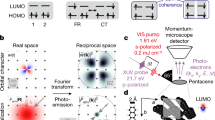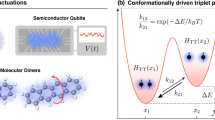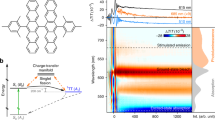Abstract
Singlet fission, in which a singlet exciton is converted to two triplet excitons, is a process that could be beneficial in photovoltaic applications. A full understanding of the dynamics of singlet fission in molecular systems requires detailed knowledge of the relevant potential energy surfaces and their (conical) intersections. However, obtaining such information is a nontrivial task, particularly for molecular aggregates. Here we investigate singlet fission in rubrene crystals using transient absorption spectroscopy and state-of-the-art quantum chemical calculations. We observe a coherent and ultrafast singlet-fission channel as well as the well-known and conventional thermally assisted incoherent channel. This coherent channel is accessible because the conical intersection for singlet fission on the excited-state potential energy surface is located very close to the equilibrium position of the ground-state potential energy surface and also because of the excitation of an intermolecular symmetry-breaking mode, which activates the electronic coupling necessary for singlet fission.
This is a preview of subscription content, access via your institution
Access options
Access Nature and 54 other Nature Portfolio journals
Get Nature+, our best-value online-access subscription
$29.99 / 30 days
cancel any time
Subscribe to this journal
Receive 12 print issues and online access
$259.00 per year
only $21.58 per issue
Buy this article
- Purchase on Springer Link
- Instant access to full article PDF
Prices may be subject to local taxes which are calculated during checkout





Similar content being viewed by others
References
Nakamura, H. Nonadiabatic Transition: Concepts, Basic Theories and Applications (World Scientific, 2012).
Shockley, W. & Queisser, H. J. Detailed balance limit of efficiency of p-n junction solar cells. J. Appl. Phys. 32, 510–519 (1961).
Hanna, M. C. & Nozik, A. J. Solar conversion efficiency of photovoltaic and photoelectrolysis cells with carrier multiplication absorbers. J. Appl. Phys. 100, 074510 (2006).
Smith, M. B. & Michl, J. Singlet fission. Chem. Rev. 110, 6891–6936 (2010).
Smith, M. B. & Michl, J. Recent advances in singlet fission. Annu. Rev. Phys. Chem. 64, 361–386 (2013).
Yost, S. R. et al. A transferable model for singlet-fission kinetics. Nat. Chem. 6, 492–497 (2014).
Alguire, E. C., Subotnik, J. E. & Damrauer, N. H. Exploring non-Condon effects in a covalent tetracene dimer: how important are vibrations in determining the electronic coupling for singlet fission? J. Phys. Chem. A 119, 299–311 (2015).
Tamura, H., Huix-Rotllant, M., Burghardt, I., Olivier, Y. & Beljonne, D. First-principles quantum dynamics of singlet fission: coherent versus thermally activated mechanisms governed by molecular π stacking. Phys. Rev. Lett. 115, 107401 (2015).
Parker, S. M., Seideman, T., Ratner, M. A. & Shiozaki, T. Model Hamiltonian analysis of singlet fission from first principles. J. Phys. Chem. C 118, 12700–12705 (2014).
Greyson, E. C., Vura-Weis, J., Michl, J. & Ratner, M. A. Maximizing singlet fission in organic dimers: theoretical investigation of triplet yield in the regime of localized excitation and fast coherent electron transfer. J. Phys. Chem. B 114, 14168–14177 (2010).
Grumstrup, E. M., Johnson, J. C. & Damrauer, N. H. Enhanced triplet formation in polycrystalline tetracene films by femtosecond optical-pulse shaping. Phys. Rev. Lett. 105, 257403 (2010).
Zimmerman, P. M., Bell, F., Casanova, D. & Head-Gordon, M. Mechanism for singlet fission in pentacene and tetracene: from single exciton to two triplets. J. Am. Chem. Soc. 133, 19944–19952 (2011).
Wilson, M. W. B. et al. Ultrafast dynamics of exciton fission in polycrystalline pentacene. J. Am. Chem. Soc. 133, 11830–11833 (2011).
Chan, W.-L. et al. Observing the multiexciton state in singlet fission and ensuing ultrafast multielectron transfer. Science 334, 1541–1545 (2011).
Chan, W.-L., Ligges, M. & Zhu, X.-Y. The energy barrier in singlet fission can be overcome through coherent coupling and entropic gain. Nat. Chem. 4, 840–845 (2012).
Teichen, P. E. & Eaves, J. D. A microscopic model of singlet fission. J. Phys. Chem. B 116, 11473–11481 (2012).
Chan, W.-L. et al. The quantum coherent mechanism for singlet fission: experiment and theory. Acc. Chem. Res. 46, 1321–1329 (2013).
Feng, X., Luzanov, A. V. & Krylov, A. I. Fission of entangled spins: an electronic structure perspective. J. Phys. Chem. Lett. 4, 3845–3852 (2013).
Beljonne, D., Yamagata, H., Brédas, J. L., Spano, F. C. & Olivier, Y. Charge-transfer excitations steer the Davydov splitting and mediate singlet exciton fission in pentacene. Phys. Rev. Lett. 110, 226402 (2013).
Berkelbach, T. C., Hybertsen, M. S. & Reichman, D. R. Microscopic theory of singlet exciton fission. II.: application to pentacene dimers and the role of superexchange. J. Chem. Phys. 138, 114103 (2013).
Renaud, N., Sherratt, P. A. & Ratner, M. A. Mapping the relation between stacking geometries and singlet fission yield in a class of organic crystals. J. Phys. Chem. Lett. 4, 1065–1069 (2013).
Akimov, A. V. & Prezhdo, O. V. Nonadiabatic dynamics of charge transfer and singlet fission at the pentacene/C60 interface. J. Am. Chem. Soc. 136, 1599–1608 (2014).
Berkelbach, T. C., Hybertsen, M. S. & Reichman, D. R. Microscopic theory of singlet exciton fission. III: crystalline pentacene. J. Chem. Phys. 141, 074705 (2014).
Zeng, T., Hoffmann, R. & Ananth, N. The low-lying electronic states of pentacene and their roles in singlet fission. J. Am. Chem. Soc. 136, 5755–5764 (2014).
Musser, A. J. et al. Evidence for conical intersection dynamics mediating ultrafast singlet exciton fission. Nat. Phys. 11, 352–357 (2015).
Renaud, N. & Grozema, F. C. Intermolecular vibrational modes speed up singlet fission in perylenediimide crystals. J. Phys. Chem. Lett. 6, 360–365 (2015).
Aragó, J. & Troisi, A. Dynamics of the excitonic coupling in organic crystals. Phys. Rev. Lett. 114, 026402 (2015).
Bakulin, A. A. et al. Real-time observation of multiexcitonic states in ultrafast singlet fission using coherent 2D electronic spectroscopy. Nat. Chem. 8, 16–23 (2016).
Fujihashi, Y. & Ishizaki, A. Fluctuations in electronic energy affecting singlet fission dynamics and mixing with charge-transfer state: quantum dynamics study. J. Phys. Chem. Lett. 7, 363–369 (2016).
Marcus, R. A. On the theory of oxidation-reduction reactions involving electron transfer. I. J. Chem. Phys. 24, 966–978 (1956).
Jortner, J. & Bixon, M. Intramolecular vibrational excitations accompanying solvent-controlled electron transfer reactions. J. Chem. Phys. 88, 167–170 (1988).
Monahan, N. R. et al. Dynamics of the triplet-pair state reveals the likely coexistence of coherent and incoherent singlet fission in crystalline hexacene. Nat. Chem. 9, 341–346 (2016).
Ma, L. et al. Singlet fission in rubrene single crystal: direct observation by femtosecond pump-probe spectroscopy. Phys. Chem. Chem. Phys. 14, 8307–8312 (2012).
Ma, L. et al. Fluorescence from rubrene single crystals: interplay of singlet fission and energy trapping. Phys. Rev. B 87, 201203 (2013).
Irkhin, P., Ryasnyanskiy, A., Koehler, M. & Biaggio, I. Absorption and photoluminescence spectroscopy of rubrene single crystals. Phys. Rev. B 86, 085143 (2012).
Sai, N., Tiago, M. L., Chelikowsky, J. R. & Reboredo, F. A. Optical spectra and exchange-correlation effects in molecular crystals. Phys. Rev. B 77, 161306 (2008).
Song, L. & Fayer, M. Temperature dependent intersystem crossing and triplet–triplet absorption of rubrene in solid solution. J. Lumin. 50, 75–81 (1991).
Venuti, E. et al. Polarized Raman spectra of a rubrene single crystal. J. Phys. Chem. C 112, 17416–17422 (2008).
Ren, Z. Q., McNeil, L. E., Liu, S. & Kloc, C. Molecular motion and mobility in an organic single crystal: Raman study and model. Phys. Rev. B 80, 245211 (2009).
West, B. A., Womick, J. M., McNeil, L. E., Tan, K. J. & Moran, A. M. Ultrafast dynamics of Frenkel excitons in tetracene and rubrene single crystals. J. Phys. Chem. C 114, 10580–10591 (2010).
Yada, H. et al. Carrier dynamics of rubrene single-crystals revealed by transient broadband terahertz spectroscopy. Appl. Phys. Lett. 105, 143302 (2014).
Takeya, J. et al. Very high-mobility organic single-crystal transistors with in-crystal conduction channels. Appl. Phys. Lett. 90, 102120 (2007).
Watanabe, K., Matsumoto, Y., Yasuike, T. & Nobusada, K. Adsorbate-localized versus substrate-mediated excitation mechanisms for generation of coherent Cs–Cu stretching vibration at Cu(111). J. Phys. Chem. A 115, 9528–9535 (2011).
Shiozaki, T., Györffy, W., Celani, P. & Werner, H.-J. Extended multi-state complete active space second-order perturbation theory: energy and nuclear gradients. J. Chem. Phys. 135, 081106 (2011).
Acknowledgements
We thank T. Uemura, S. Watanabe, K. Miwa and N. Namba for their help in fabricating the rubrene crystals and A. Ishizaki for insightful discussion. This work was supported by the Grant-in-Aid for Scientific Research (A) from the Japan Society for the Promotion of Sciences (grant no. 22245001 and 25248006), Grant-in-Aid for Challenging Exploratory Research from Japan Society for the Promotion of Science (grant no. 24655011), Kyoto University Global COE program, Grants for Excellent Graduate Schools, MEXT, Japan, and the programme of Network of Joint Research Centre for Advanced Materials and Devices.
Author information
Authors and Affiliations
Contributions
K.M. performed the measurements and analysed the data with the help of S.Tanaka; Y.K. performed the quantum chemical calculations with the help of T.Y.; K.W. supervized the measurements and contributed the mechanisms of coherent excitation and coherent phonon generation; J.T. synthesized and supplied rubrene crystallines; S.Takahashi performed follow-up measurements; Y.M., K.M., Y.K., and K.W. wrote the manuscript with contributions from T.S.; all authors discussed the results and contributed to the manuscript; Y.M. organized and supervized the project.
Corresponding author
Ethics declarations
Competing interests
The authors declare no competing financial interests.
Supplementary information
Supplementary information
Supplementary information (PDF 0 kb)
Rights and permissions
About this article
Cite this article
Miyata, K., Kurashige, Y., Watanabe, K. et al. Coherent singlet fission activated by symmetry breaking. Nature Chem 9, 983–989 (2017). https://doi.org/10.1038/nchem.2784
Received:
Accepted:
Published:
Issue Date:
DOI: https://doi.org/10.1038/nchem.2784
This article is cited by
-
Singlet fission as a polarized spin generator for dynamic nuclear polarization
Nature Communications (2023)
-
Steering the multiexciton generation in slip-stacked perylene dye array via exciton coupling
Nature Communications (2022)
-
Accelerating symmetry-breaking charge separation in a perylenediimide trimer through a vibronically coherent dimer intermediate
Nature Chemistry (2022)
-
Exploring optimal multimode vibronic pathways in singlet fission of azaborine analogues of perylene
Photochemical & Photobiological Sciences (2022)
-
Vacancy control in acene blends links exothermic singlet fission to coherence
Nature Communications (2021)



